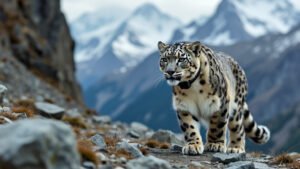Introduction
Monitoring snow leopard populations is crucial for their conservation. This article explores the advanced technologies employed in tracking these elusive cats. We will delve into the use of camera traps, GPS collars, drones, genetic analysis, and satellite tracking
Each section will provide detailed insights into how these technologies work, their advantages, and their contributions to snow leopard conservation. Join us as we uncover the innovative methods that help protect one of the world’s most mysterious big cats
Camera Traps in Snow Leopard Monitoring
Camera traps have become an indispensable tool in the monitoring of snow leopard populations. These devices, equipped with motion sensors, capture images or videos when an animal passes by, providing researchers with invaluable data
The deployment of camera traps has revolutionized wildlife research, offering a non-invasive and efficient method to study these elusive creatures
How Camera Traps Work
Camera traps are strategically placed along trails, ridges, and other locations frequented by snow leopards. They are typically camouflaged to blend into the environment, reducing the risk of disturbance
When an animal triggers the motion sensor, the camera records an image or video. These images are timestamped and sometimes geotagged, allowing researchers to analyze the time, location, and behavior of the animal
The effectiveness of camera traps relies on their ability to operate in harsh conditions
Snow leopards inhabit remote and rugged terrains with extreme weather, and camera traps must be durable enough to withstand these environments. Advances in technology have led to the development of more robust and weather-resistant models, ensuring consistent data collection
Advantages of Camera Traps
One of the primary advantages of camera traps is their non-invasive nature. Unlike methods that require physical capture or close proximity, camera traps can monitor wildlife without disturbing their natural behavior. This is particularly important for snow leopards, which are notoriously shy and elusive
Camera traps provide continuous monitoring over extended periods, offering a comprehensive view of animal activity
This continuous data collection is crucial for understanding the behavior, movement patterns, and population dynamics of snow leopards. By analyzing these data, researchers can identify key habitats, assess population sizes, and monitor changes over time
Moreover, camera traps can capture images of multiple species, providing a broader understanding of the ecosystem. This multi-species monitoring can reveal interactions between snow leopards and their prey or competitors, contributing to a holistic approach to conservation
Case Studies Using Camera Traps
Numerous case studies highlight the effectiveness of camera traps in snow leopard research
In Mongolia’s Tost Mountains, a long-term camera trapping project has provided critical insights into snow leopard population density and distribution. The data collected has been instrumental in establishing protected areas and implementing conservation strategies
In India, camera traps have been used in the rugged terrains of the Himalayas to study snow leopard populations. Researchers have been able to identify individual leopards through their unique spot patterns, track their movements, and estimate population sizes. This information has been vital for developing community-based conservation programs that involve local residents in protecting these cats
The Snow Leopard Trust, an organization dedicated to conserving snow leopards and their habitats, has successfully used camera traps across various countries. Their projects have not only contributed to scientific knowledge but have also engaged local communities, raising awareness and fostering a sense of stewardship
In Kyrgyzstan, camera traps have helped monitor snow leopards in the Sarychat-Ertash Nature Reserve. The images collected have provided evidence of breeding populations and have been used to advocate for stronger protection measures. This has led to increased funding and support for conservation initiatives
Camera traps have also played a crucial role in identifying threats to snow leopards. In some regions, images captured by camera traps have documented instances of poaching and illegal wildlife trade. This information has been used to strengthen law enforcement and anti-poaching efforts, highlighting the broader impact of camera traps beyond ecological research
GPS Collars for Tracking Snow Leopards
GPS collars are another vital technology used to monitor snow leopard populations. These collars, equipped with Global Positioning System (GPS) technology, allow researchers to track the movements and behaviors of snow leopards in real-time. By providing precise location data, GPS collars offer insights into the spatial ecology of these elusive big cats
Technology Behind GPS Collars
GPS collars use satellite signals to determine the exact location of an animal. The collars are fitted around the neck of a snow leopard and contain a GPS receiver, a battery, and a data storage unit. The GPS receiver collects location data at predetermined intervals, which is then stored in the collar or transmitted via satellite or cellular networks to researchers
The design of GPS collars has evolved to ensure minimal impact on the animals. Modern collars are lightweight and designed to fall off after a certain period or if the battery runs out, reducing the risk of long-term harm. Additionally, advancements in battery technology have extended the operational life of these collars, allowing for longer monitoring periods
Researchers can program the collars to collect data at specific intervals, such as every hour or even every minute, depending on the research objectives. This flexibility enables detailed studies of movement patterns, habitat use, and behavior. For example, high-frequency data collection can reveal fine-scale movements during hunting or denning periods
Implementation and Challenges
Implementing GPS collars in snow leopard research involves several steps, including capturing the animal, fitting the collar, and monitoring the data
Capturing a snow leopard requires careful planning and expertise to ensure the safety and well-being of the animal. Tranquilizers are typically used to immobilize the snow leopard, allowing researchers to fit the collar and conduct health assessments before release
One of the significant challenges in using GPS collars is the rugged and remote habitat of snow leopards. The harsh terrain and extreme weather conditions can affect both the capture process and the performance of the collars. Researchers must often navigate difficult landscapes and endure severe weather to track and monitor the collared animals
Another challenge is the potential for collar malfunctions or loss. Technical issues, such as battery failure or signal interference, can result in data loss
Additionally, snow leopards may lose their collars due to physical damage or natural shedding. Despite these challenges, the valuable data obtained from GPS collars make them an essential tool in snow leopard research
Success Stories with GPS Collars
GPS collars have provided remarkable insights into the lives of snow leopards, leading to several success stories in conservation and research
In the Altai Mountains of Russia, GPS collars have been used to study the movement patterns of snow leopards, revealing extensive home ranges and critical habitat areas. This information has been crucial in identifying key conservation zones and reducing human-wildlife conflicts
In Nepal, a groundbreaking study used GPS collars to track snow leopards across the Himalayas
The data collected showed that snow leopards use both high-altitude areas and lower elevations, often overlapping with human settlements. This knowledge has helped develop community-based conservation programs that mitigate conflict and promote coexistence
The Snow Leopard Trust has successfully used GPS collars in Mongolia to study snow leopard behavior and ecology. The data from collared snow leopards have provided insights into their hunting strategies, prey preferences, and territorial behavior. This information has been vital in creating effective management plans and conservation strategies
In China, GPS collars have been instrumental in studying the impact of climate change on snow leopard habitats
Researchers have tracked the movements of snow leopards in response to changing environmental conditions, such as melting glaciers and shifting vegetation zones. These studies have highlighted the need for adaptive conservation measures to address the impacts of climate change
GPS collars have also played a critical role in transboundary conservation efforts. Snow leopards often roam across national borders, and GPS tracking has facilitated collaboration between countries like India, China, and Bhutan. By sharing data and coordinating conservation actions, these countries have improved the protection of snow leopard populations that traverse political boundaries
Utilizing Drones in Snow Leopard Research
Drones have emerged as a cutting-edge technology in the field of wildlife research, including the study of snow leopard populations. These unmanned aerial vehicles (UAVs) offer a unique perspective and a range of capabilities that enhance the monitoring and conservation of these elusive big cats
Drone Technology and Its Application
Drones used in wildlife research are equipped with high-resolution cameras, GPS systems, and sometimes thermal imaging sensors
These features allow drones to capture detailed images and videos, track animal movements, and survey large and inaccessible areas. In snow leopard research, drones are particularly valuable for surveying the rugged and remote mountainous habitats where these cats live
The application of drones in snow leopard research involves various tasks, including habitat mapping, population surveys, and behavioral studies
Researchers use drones to create high-resolution maps of snow leopard habitats, identifying key features such as prey abundance, water sources, and potential den sites. These maps are crucial for understanding the spatial ecology of snow leopards and planning conservation strategies
Drones also enable population surveys by capturing images and videos of snow leopards and their prey. By flying predetermined routes, drones can cover extensive areas more efficiently than ground-based surveys. The aerial perspective provided by drones allows researchers to spot animals that might be missed from the ground, providing more accurate population estimates
Benefits of Using Drones
One of the primary benefits of using drones in snow leopard research is their ability to access remote and difficult-to-reach areas
Snow leopards inhabit some of the most rugged and inaccessible terrains on Earth, making traditional survey methods challenging and time-consuming. Drones can easily navigate these areas, capturing data that would otherwise be difficult to obtain
Drones also offer a non-invasive monitoring method, reducing the risk of disturbing snow leopards and other wildlife. Unlike ground-based surveys that might involve human presence and potential stress to the animals, drones can operate at a distance, minimizing disruption to their natural behavior. This non-invasive approach is crucial for studying shy and elusive species like snow leopards
The use of drones improves the efficiency and cost-effectiveness of wildlife research. Traditional methods, such as ground surveys and helicopter flights, can be labor-intensive and expensive
Drones provide a more affordable alternative, allowing researchers to cover large areas quickly and repeatedly, which is essential for long-term monitoring and data collection
Examples of Drone Usage
In recent years, several projects have successfully employed drones in snow leopard research. In Kyrgyzstan, researchers have used drones to map snow leopard habitats in the Tien Shan mountains
The high-resolution images captured by drones have provided detailed information on the landscape features, prey availability, and potential human disturbances, aiding in the development of targeted conservation actions
In the Himalayas, drones have been used to monitor snow leopard populations and their prey. Researchers have flown drones over remote valleys and ridges, capturing images of snow leopards, blue sheep, and other wildlife. These surveys have revealed important insights into the population densities and distribution patterns of snow leopards, contributing to more effective conservation planning
The Snow Leopard Trust has utilized drones in Mongolia to study snow leopard behavior and habitat use
By flying drones over known snow leopard territories, researchers have been able to observe the cats’ movements, hunting strategies, and interactions with their environment. This information has been invaluable in understanding the ecological needs of snow leopards and identifying critical habitats for protection
In China, drones have played a key role in anti-poaching efforts. Equipped with thermal imaging sensors, drones have been used to patrol protected areas and detect illegal hunting activities. This technology has enhanced law enforcement capabilities, leading to increased protection for snow leopards and other endangered species
Drones have also been used in educational and community outreach programs. By sharing aerial footage of snow leopards and their habitats, conservation organizations have been able to raise awareness and engage local communities in wildlife protection efforts
This visual approach helps convey the importance of snow leopard conservation and fosters a sense of stewardship among residents living in snow leopard habitats
Genetic Analysis in Snow Leopard Conservation
Genetic analysis has become a crucial tool in snow leopard conservation, offering insights into the genetic diversity, population structure, and health of these elusive cats. By analyzing DNA from various sources, researchers can gather vital information to inform conservation strategies and enhance efforts to protect snow leopard populations
Methods of DNA Collection
The collection of DNA from snow leopards can be challenging due to their elusive nature and remote habitats
However, several non-invasive methods have been developed to obtain genetic material without capturing or disturbing the animals. These methods include collecting scat (feces), hair, urine, and even environmental DNA (eDNA) from the surrounding environment
Scat collection is one of the most common methods used. Researchers identify and collect snow leopard scat from their habitats, often along trails, ridges, and marking sites. Once collected, the scat is preserved and sent to laboratories for DNA extraction and analysis. This method provides a wealth of genetic information while minimizing disturbance to the animals
Hair samples can be collected using hair snares, which are strategically placed to snag hairs as snow leopards pass by. These snares are often set along known travel routes or near marking sites. The collected hair samples are then analyzed for genetic material, providing another valuable source of DNA
Urine samples can be collected from snow leopard marking sites, such as rocks or vegetation where they spray urine to mark their territory
Specialized collection techniques are used to obtain these samples without contamination. The DNA extracted from urine can provide insights into the genetic makeup and health of individual snow leopards
Environmental DNA (eDNA) is a newer method that involves collecting DNA from the environment, such as water or soil samples, where snow leopards have been present. This approach allows researchers to detect the presence of snow leopards and other wildlife without direct observation. eDNA analysis is particularly useful for assessing biodiversity and monitoring elusive species in large or difficult-to-access areas
Techniques for Genetic Analysis
Once DNA samples are collected, various techniques are used to analyze the genetic material
Polymerase Chain Reaction (PCR) is a fundamental technique that amplifies specific DNA sequences, making it possible to study even small or degraded samples. PCR is often used to identify individual snow leopards, assess genetic diversity, and detect specific genetic markers
Microsatellite analysis is another common technique used in genetic studies. Microsatellites are short, repeating sequences of DNA that vary among individuals. By analyzing these variations, researchers can assess genetic diversity, relatedness, and population structure. Microsatellite data can reveal important information about gene flow, inbreeding, and the connectivity of snow leopard populations
Mitochondrial DNA (mtDNA) analysis focuses on the genetic material found in mitochondria, which is passed down from mother to offspring
MtDNA is useful for studying maternal lineages and understanding the evolutionary history of snow leopard populations. This technique can provide insights into historical population dynamics and the impacts of past environmental changes
Next-generation sequencing (NGS) is a more advanced and comprehensive approach to genetic analysis. NGS allows for the sequencing of entire genomes, providing a detailed view of the genetic makeup of snow leopards
This technology can identify genetic variations associated with disease resistance, adaptation to high-altitude environments, and other important traits. NGS is particularly valuable for conservation genetics, as it offers a holistic understanding of genetic health and diversity
Impact of Genetic Data on Conservation Efforts
Genetic data obtained from snow leopards has had a profound impact on conservation efforts. By understanding the genetic diversity and population structure of snow leopards, researchers can make informed decisions about management and protection strategies
For example, areas with low genetic diversity may require targeted conservation actions to enhance gene flow and prevent inbreeding
Genetic analysis has also been instrumental in identifying distinct populations and subspecies of snow leopards. This information is crucial for developing region-specific conservation plans and ensuring the protection of unique genetic lineages. By recognizing and preserving genetic diversity, conservationists can enhance the resilience and adaptability of snow leopard populations
In India, genetic studies have revealed distinct populations of snow leopards in different regions of the Himalayas
This information has guided the creation of protected areas and corridors that facilitate movement and gene flow between populations. These measures help maintain genetic diversity and support the long-term survival of snow leopards in fragmented landscapes
In Mongolia, genetic analysis has provided insights into the connectivity of snow leopard populations across large and remote areas. By identifying key corridors and habitats, conservationists have been able to implement landscape-level conservation strategies that promote the movement and genetic exchange of snow leopards
Genetic data has also played a role in combating illegal wildlife trade. DNA analysis can be used to trace the origin of snow leopard parts and products, aiding law enforcement in identifying poaching hotspots and trafficking routes
This information is vital for strengthening anti-poaching efforts and reducing the illegal trade of snow leopards and their parts
Moreover, genetic analysis contributes to understanding the impacts of climate change on snow leopard populations. By studying genetic adaptations to high-altitude environments, researchers can predict how snow leopards might respond to changing climate conditions
This knowledge is essential for developing adaptive management strategies that address the challenges posed by climate change
Satellite Tracking and Its Importance
Satellite tracking has emerged as a crucial technology for monitoring snow leopard populations. By providing real-time location data, satellite tracking enables researchers to study the movements, habitat use, and behavior of snow leopards across vast and remote landscapes
This technology has revolutionized wildlife research and conservation, offering insights that were previously unattainable
How Satellite Tracking Works
Satellite tracking involves fitting snow leopards with collars that transmit location data to satellites orbiting the Earth
These collars are equipped with GPS receivers and transmitters that communicate with satellites to determine the animal’s precise location. The data collected is then transmitted to researchers, who can monitor the snow leopard’s movements in real-time or at scheduled intervals
The collars used in satellite tracking are designed to be lightweight and durable, minimizing the impact on the snow leopards. Advances in battery technology and satellite communication have extended the operational life of these collars, allowing for long-term monitoring. Additionally, the collars are often programmed to release automatically after a certain period, ensuring the safety of the animals
Researchers can use satellite tracking to collect a wide range of data, including location, speed, altitude, and temperature. This information is invaluable for studying the spatial ecology of snow leopards, understanding their habitat preferences, and identifying critical areas for conservation
Integrating Satellite Data
The integration of satellite tracking data with other sources of information enhances the understanding of snow leopard ecology and behavior
Researchers can combine satellite data with environmental variables such as vegetation cover, prey availability, and human activities to analyze how these factors influence snow leopard movements and habitat use
Geographic Information Systems (GIS) are commonly used to visualize and analyze satellite tracking data. GIS allows researchers to create detailed maps of snow leopard territories, migration routes, and core habitats. These maps can reveal patterns and trends that are crucial for effective conservation planning
Satellite data can also be integrated with other monitoring technologies, such as camera traps and drones, to provide a comprehensive view of snow leopard populations
For example, camera trap images can be correlated with satellite tracking data to validate the presence and behavior of individual snow leopards. Similarly, drone surveys can complement satellite data by providing high-resolution images of specific areas
Conservation Successes with Satellite Tracking
Satellite tracking has led to several notable successes in snow leopard conservation. In the Tost Mountains of Mongolia, satellite tracking has provided detailed insights into the home ranges and movement patterns of snow leopards
This information has been critical in identifying key habitats and corridors, leading to the establishment of protected areas and conservation zones
In Bhutan, satellite tracking has been used to study the transboundary movements of snow leopards between Bhutan and India. The data collected has highlighted the importance of cross-border cooperation and the need for coordinated conservation efforts. This collaboration has resulted in joint conservation initiatives and the creation of transboundary protected areas
In Nepal, satellite tracking has revealed the seasonal movements of snow leopards between high-altitude areas and lower elevations. This knowledge has informed the development of community-based conservation programs that address human-wildlife conflicts
By understanding the movement patterns of snow leopards, local communities can implement measures to protect their livestock and reduce retaliatory killings
The Snow Leopard Trust has successfully used satellite tracking to monitor snow leopards in multiple countries, including Kyrgyzstan, India, and Pakistan. The data obtained has been instrumental in identifying critical habitats, assessing the impacts of human activities, and guiding conservation interventions. These efforts have contributed to the protection and recovery of snow leopard populations in these regions
Satellite tracking has also played a crucial role in mitigating the impacts of climate change on snow leopards. By studying the movements and habitat use of snow leopards in response to changing environmental conditions, researchers can develop adaptive management strategies
For example, satellite data can help identify climate refugia—areas that remain suitable for snow leopards despite climate change—ensuring their protection
Conclusion
The use of advanced technologies in monitoring snow leopard populations has significantly enhanced our understanding and conservation of these elusive cats. Each technology—camera traps, GPS collars, drones, genetic analysis, and satellite tracking—plays a vital role in providing detailed and accurate data essential for effective conservation strategies
Camera traps offer non-invasive, continuous monitoring that captures invaluable data on snow leopard behavior, population dynamics, and interactions with their ecosystem
GPS collars provide real-time location data, revealing movement patterns and habitat use, crucial for identifying critical conservation areas and mitigating human-wildlife conflicts. Drones offer a versatile and cost-effective method for surveying remote and rugged terrains, improving the efficiency and scope of population surveys and habitat mapping
Genetic analysis allows researchers to assess genetic diversity, population structure, and health, guiding targeted conservation actions to enhance genetic resilience and adaptability. Satellite tracking delivers precise, long-term data on snow leopard movements across vast landscapes, informing landscape-level conservation planning and cross-border cooperation
Together, these technologies form a comprehensive toolkit for snow leopard conservation, enabling researchers and conservationists to develop informed, science-based strategies to protect and preserve snow leopard populations. As technology continues to advance, these methods will become even more effective, ensuring the long-term survival of snow leopards in their natural habitats











